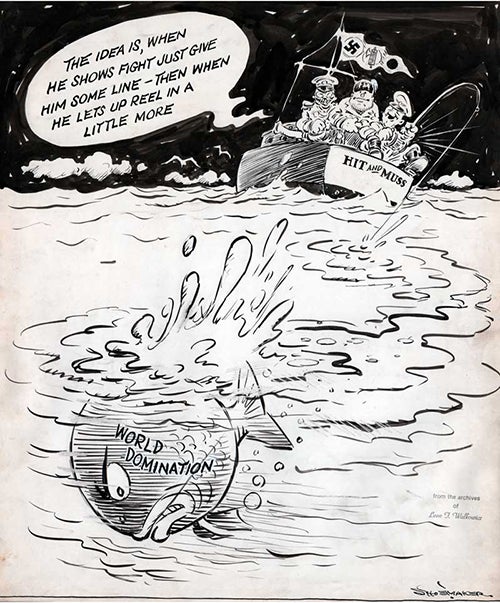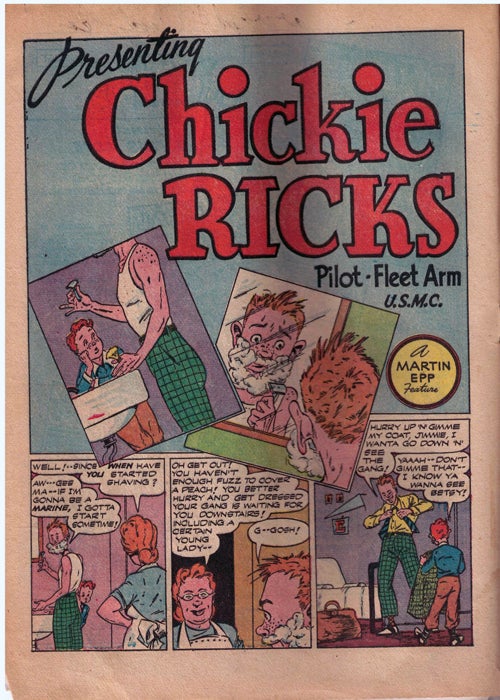
“Is It Worth Saving?” (February 26, 1941)
by Vaughn Richard Shoemaker (1902-1991)
22 x 24 in., ink on paper
Coppola Collection
Denis Mack Smith (Mussolini’s Roman Empire) notes that the history of Fascism in Italy is tied to the rise and fall of Mussolini (the post-WWI period, 1922-1933, concurrent with the rise of Hitler; then the alliance with Hitler and through WWII).
It is quite impossible not to think about the current US President as Mack Smith depicts Mussolini:
He is an individual who was violent, arrogant, and insensitive, for whom the possession of power was the highest virtue. He could not tolerate having his authority called into question, and he loved to convey the impression that he did not need expert advice on any subject. Yet, his style was merely based on his bombastic and intimidating statements and the threat, if not the actual use, of his military forces. His genius, if it can be called that, was as a propagandist.
German organization and its power in Europe was clearly superior, and Hitler generally avoided taking Mussolini into his confidence about Nazi plans for conquest. Italy was the junior partner. Mussolini informed Hitler just a week before the Nazi invasion of Poland that Italy was ready to fight, but only if Germany would supply the munitions. To Hitler, I think Mussolini was a way to outsource the Nazi strategy for keeping check on the Mediterranean front line, including Africa, where Italy had been successful in some costly battles.
Historians consider that the Italian military was a lot worse off than Mussolini was letting on, and that an alliance with Hitler was preferable to being invaded by the Germans. On the other hand, Italy might also be vulnerable to attack by Britain if it appeared to be too aggressive. Mussolini, splitting the difference, coined the term non-belligerence. Italy would be an ally to the Germans, but not necessarily part of the proactive moves taking place in northern Europe. Mussolini entered the fight in June, 1940, almost a year after the German invasion of Poland kicked off WWII, following Hilter’s successes in April-May 1940, with the conquests of Norway, Denmark, Belgium, and Holland, as well as the pressure in France, which surrendered in June.
Mussolini ran an inept “parallel war” on the Mediterranean front, ending with disastrous loses in Greece and North Africa in late 1940. Only German intervention kept the Italian dictator afloat.
On February 2, 1941, Mussolini declared the southern portion of Italy to be a war zone and put it under martial law.
On February 5, 1941, Adolf Hitler scolded Benito Mussolini for his troops’ retreat in the face of British advances in Libya, demanding that Mussolini command his forces to resist. But the next day, British forces captured El Agheila, Libya, defeating the Italian defense. After that, Churchill halted the British advance in North Africa and began moving troops to assist in the defense of Greece.
On February 23, Mussolini made a speech in Rome in which he admitted that Italy had experienced “gray days” in the war so far, but maintained that such things happen “in all wars” and that “the final result will be Axis victory.” And on February 24, Hitler gave a speech in Munich on the 21st anniversary of the founding of the Nazi Party declaring that offensives would intensify in the coming months.
The New York Times reproduced the entire text of Mussolini’s February 23, 1941 speech. Here is a passage:
Let me say now that what is occurring in the United States is one of the most colossal mystifications in all history. Illusion and lying are the basis of American interventionism-illusion that the United States is still a democracy, when instead it is a political and financial oligarchy dominated by Jews, through a personal form of dictatorship. The lie is that the Axis powers, after they finish Great Britain, want to attack America.
Neither in Rome nor Berlin are such fantastic plans as this prepared. These projects could not be made by those who have an inclination for the madhouse. Though we certainly are totalitarian and will always be so, we have our feet on hard ground. Americans who will read what I say should be calm and not believe in the existence of a big bad wolf who wants to devour them.
In all cases it is more likely that the United States, before it is attacked by Axis soldiers, will be attacked by the not well known but very warlike inhabitants of the planet Mars, who will descend from the stratosphere in unimaginable flying fortresses.
The Chicago Times reported on the Mussolini speech.
He hadn’t broken the backs of the Greeks. They had pushed his face in. He hadn’t chased the British out of North Africa. They had chased him out of Libya. It might be regarded as odd of the man to magnify the British victory as he did. He preferred to round out the picture of a major military disaster rather than allow the Italian people to believe he hadn’t made adequate preparations for the campaign.
He threw the responsibility upon the Fascist generals, many of whom have been sent into retirement. But Mussolini consoled his people. Herr Hitler and the Nazis would save them. If that’s a consolation, his people might get in touch with the people in other countries taken over in protective custody by Herr Hitler.
The Italians may end up getting a dose of something stronger than castor oil.
On February 22, 1941, British and South African forces defeated the Italians at Jilib, Somalia. Mussolini was widely regarded as being dragged along in Hilter’s wake, which likely explains the cartoon.
 “Mythos: Captain America p. 15” (2008)
“Mythos: Captain America p. 15” (2008) “Mythos: Captain America p. 11” (2008)
“Mythos: Captain America p. 11” (2008)

 “Walking Monk” (2015)
“Walking Monk” (2015)

 “Chinese Conquest” (1940)
“Chinese Conquest” (1940) If you ever find yourself in Tianjin, China, make time to spend at the merchant-filled “Ancient Culture Street” called Guwenhua Jie. Among the street snacks and the calligraphy, there are some high quality carvers and other artists.
If you ever find yourself in Tianjin, China, make time to spend at the merchant-filled “Ancient Culture Street” called Guwenhua Jie. Among the street snacks and the calligraphy, there are some high quality carvers and other artists.


 “Still Life with Tangerine and Sugar Bowl (magic is still possible)” (2017)
“Still Life with Tangerine and Sugar Bowl (magic is still possible)” (2017) “Presenting Chickie Ricks p 1” (August 1943) by Bob Powell
“Presenting Chickie Ricks p 1” (August 1943) by Bob Powell
 “Presenting Chickie Ricks p 8” (August 1943) by Bob Powell
“Presenting Chickie Ricks p 8” (August 1943) by Bob Powell

 “Captain Marvel” (May 12, 1972)
“Captain Marvel” (May 12, 1972)